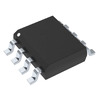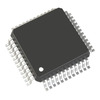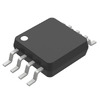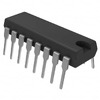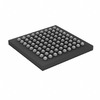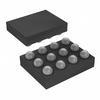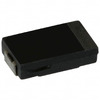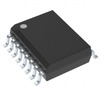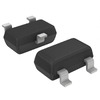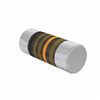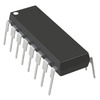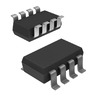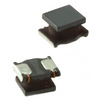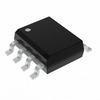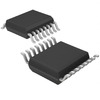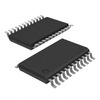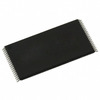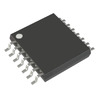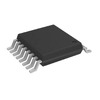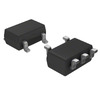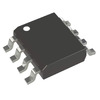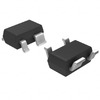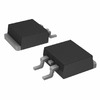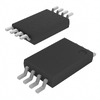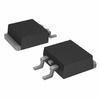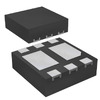How to Use the ATMEGA328-PU Microcontroller for Smart Hardware Projects
The ATMEGA328-PU is a popular microcontroller widely used in embedded systems and electronics projects, thanks to its balance of power efficiency and processing speed. This article provides an overview of the microcontroller’s key features, pin configurations, and specifications, as well as insights into its common applications and performance optimization techniques. Whether you’re an electronics hobbyist or a professional developer, this guide will help you understand why the ATMEGA328-PU is a go-to choice for versatile and reliable system design.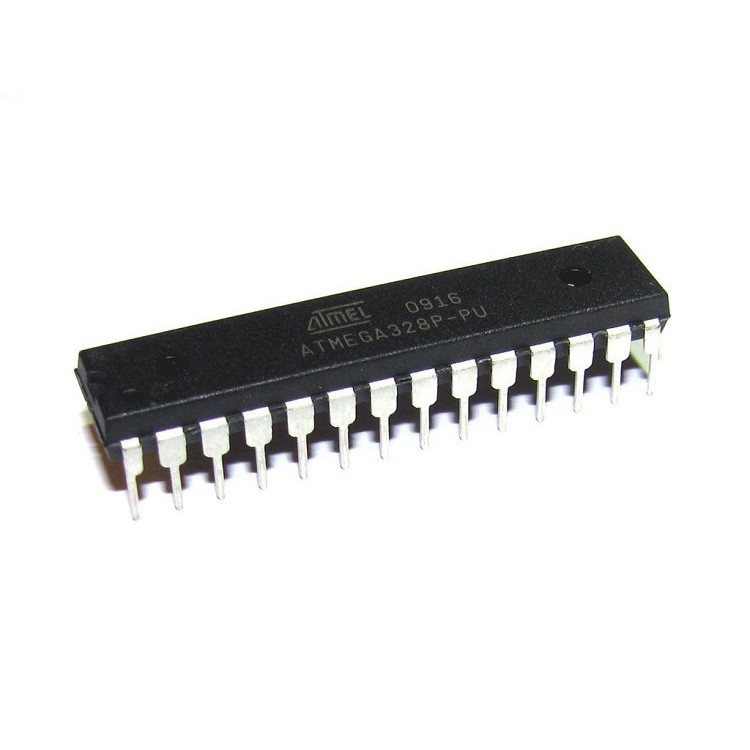
Overview of the ATMEGA328-PU Microcontroller
The ATMEGA328-PU is a low-power 8-bit CMOS microcontroller built using the AVR enhanced RISC architecture. This design allows it to execute multiple instructions quickly, thanks to its ability to access two registers simultaneously within a single clock cycle. As a result, it achieves performance up to ten times faster than standard CISC microcontrollers, making it suitable for applications that require a balance between power efficiency and processing speed.
The ATMEGA328-PU can operate with a supply voltage of up to 5.5 volts and includes 32KB of program memory. It runs at a maximum speed of 20MHz and supports a variety of communication interfaces such as UART, SPI, I2C, and ADC. This microcontroller is versatile and compatible with several other models, including the ATMEGA328-AU, ATMEGA328-MMHR, and ATMEGA328-MUR, offering multiple options for designers working on different types of projects.
Replacement and equivalent
ATMEGA328-PU Symbol and Footprint

Key Specifications of ATMEGA328-PU

Features of the ATMEGA328-PU Microcontroller
The ATMEGA328-PU microcontroller comes with several notable features that make it a versatile option for various applications.
SRAM Memory
The ATMEGA328-PU includes 2KB of SRAM, which serves as a temporary storage space for data during runtime, supporting efficient data handling.
Hardware Multiplier
This microcontroller has a built-in hardware multiplier that can perform complex calculations in just two clock cycles, enabling faster data processing.
General-Purpose Registers
It is equipped with 32 general-purpose 8-bit registers that operate in a static mode, allowing for efficient processing and lower power consumption.
EEPROM Memory
The microcontroller has 1024 bytes of EEPROM memory, which allows up to 100,000 erase and write cycles, making it suitable for applications that require frequent data storage and retrieval.
Flash Memory
The ATMEGA328-PU features 32KB of flash memory, providing ample space for program storage and updates, making it easier to modify and upgrade software.
In-System Programming
The device supports in-system programming through its boot section, which enables users to modify and control the program code without removing the microcontroller from the circuit. This feature ensures data integrity even in the event of power loss.
Operating Speed
The microcontroller can operate at a clock speed of up to 20MHz, achieving processing performance of up to 20 million instructions per second (MIPS), making it a reliable choice for high-speed applications.
Instruction Set
It comes with a set of 131 instructions, allowing it to execute a wide range of operations with efficiency and speed.
Peripheral Interfaces
The ATMEGA328-PU provides a variety of peripherals, including timers, counters, and capacitive sensing channels, which expand its capability to interface with various external devices and components, enhancing its versatility in different projects.
Uses of ATMEGA328-PU
Smart Hardware
The ATMEGA328-PU is used in a variety of smart hardware devices, including smart bracelets, smart watches, and smart speakers.
IoT Devices
It is applied in many IoT products, such as smart lighting systems, smart thermometers, and smart door locks.
Audio and Video Equipment
This microcontroller is used for controlling and processing data in audio and video devices like cameras and smart speakers.
Sensor Interface
The ATMEGA328-PU can be found in systems that use sensors, including light sensors, humidity sensors, and temperature sensors, for monitoring environmental conditions.
Game Control Board
It plays a role in developing game control boards, such as those used in electronic pets and smart toys.
Robotics
The microcontroller is used for managing robot movements and collecting data from sensors in various types of robots, including service robots and educational robots.
Embedded Systems
It is utilized in integrated embedded systems that require controllers, such as medical equipment, industrial control systems, and smart home devices.
Pin Configuration and Description of ATMEGA328-PU
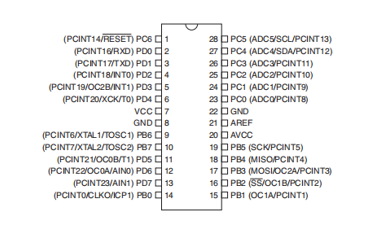
VCC
The VCC pin provides the digital supply voltage to power the internal circuitry of the microcontroller. It should be connected to a stable and clean voltage source to ensure the proper functioning of all digital components.
GND
The GND pin serves as the ground reference for the microcontroller. It completes the electrical circuit and ensures a consistent voltage reference.
Port B [PB7:0] XTAL1/XTAL2/TOSC1/TOSC2
Port B is an 8-bit bidirectional I/O port with internal pull-up resistors that can be enabled or disabled for each pin. In output mode, Port B’s pins provide balanced drive capability for both source and sink operations. In input mode, these pins will provide current when pulled low if the pull-up resistors are enabled. During a reset, Port B pins switch to a high-impedance state, independent of clock activity. Depending on clock settings, PB6 and PB7 can serve as inputs and outputs for the inverting oscillator amplifier or as TOSC1 and TOSC2 for the Asynchronous Timer/Counter2.
Port C [PC5:0]
Port C is a 7-bit bidirectional I/O port with internal pull-up resistors. Each pin can be configured as an input or output independently. The pins have balanced drive strength for sinking and sourcing current. In reset mode, Port C pins switch to a high-impedance state, regardless of the clock’s status. This port is often used for connecting analog peripherals or sensors.
PC6/RESET
PC6 functions as either an I/O pin or a Reset input, depending on the state of the RSTDISBL fuse. If the fuse is enabled, PC6 operates as a regular I/O pin with different electrical characteristics from other Port C pins. If not, PC6 serves as a Reset pin that triggers a reset when held low for a specified duration.
Port D [PD7:0]
Port D is an 8-bit bidirectional I/O port with internal pull-up resistors. The output pins can source or sink current with balanced drive capacity. When configured as inputs, Port D pins supply current when pulled low if pull-up resistors are enabled. During a reset, these pins switch to a high-impedance state to avoid affecting external circuits.
AVCC
The AVCC pin provides power to the analog components of the microcontroller, such as the A/D Converter and analog pins. It should be connected to VCC, even if the A/D Converter is not used. If the ADC is active, connect AVCC to VCC through a low-pass filter to minimize noise.
AREF
The AREF pin is the analog reference voltage input for the A/D Converter. It defines the upper range of input voltages for ADC measurements. Connecting AREF to a stable reference voltage ensures accurate readings from analog channels.
ADC7:6 [TQFP and VQFN Package Only]
ADC7 and ADC6 are available only in TQFP and VQFN packages. They serve as additional analog inputs for the A/D Converter and are powered by the analog supply voltage. They function as 10-bit ADC channels, offering extra flexibility for applications that need more analog inputs.
Boosting ATMEGA328-PU Performance
Improving the performance of the ATMEGA328-PU microcontroller can be achieved through a series of strategies that target different areas of its operation.
Peripheral Optimization
Turning off peripherals that are not needed helps the microcontroller run more efficiently. Many peripherals, such as timers, ADCs (Analog-to-Digital Converters), and communication modules like UART or SPI, can consume power and processing resources even when not in use. Disabling these when idle frees up resources for other tasks. Additionally, adjusting the modes of active peripherals, such as setting them to low-power or sleep modes, helps the microcontroller operate in a more efficient way.
Power Management
Lowering the operating frequency and supply voltage reduces overall power consumption. Running at a lower frequency means the microcontroller performs fewer operations per second, leading to less power usage. Setting the supply voltage to match the minimum needed for a given frequency further reduces power draw. Putting inactive modules into sleep mode also helps conserve energy, extending battery life and making the system more efficient.
Hardware Adjustments
Changes to the hardware configuration can also boost system performance. Using faster memory, such as low-latency RAM, helps speed up data access. Reducing the values of resistors or capacitors in signal paths can decrease delays and improve signal transmission. These hardware adjustments allow the microcontroller to process information faster, resulting in better overall speed.
Software Optimization
Streamlining loops, refining algorithms, and using coding techniques that require fewer resources can improve execution times. Reducing the number of iterations in loops or working with smaller data sets helps minimize processing time. Simplifying code to reduce memory usage or processing overhead also makes the software run more efficiently, allowing the microcontroller to perform tasks faster and with fewer resources.
Frequently Asked Questions [FAQs]
1. What is the ATMEGA328-PU?
The ATMEGA328-PU is a microcontroller commonly used in embedded systems, particularly in Arduino boards. It plays a key role in executing commands and processing data, making it a popular choice among both hobbyists and professionals.
2. What is its clock speed?
The ATMEGA328-PU typically operates at a clock speed of 16MHz. This clock speed can be adjusted to fit the needs of different projects, giving developers the option to modify performance based on project-specific requirements and limitations.
3. What is the operating temperature range?
The microcontroller works reliably within a temperature range of -40°C to 85°C, making it suitable for a wide variety of environments. Whether used in cold winter conditions or in high-temperature industrial settings, the ATMEGA328-PU continues to perform steadily.
4. What are its common uses?
The ATMEGA328-PU is widely used in several Arduino models due to its affordability and low power consumption. It is commonly found in the Arduino Uno, Arduino Pro Mini, and Arduino Nano. These boards, among others, often incorporate this microcontroller for projects that benefit from its cost-effective and energy-efficient nature.
Momba anay
ALLELCO LIMITED
Hamaky bebe kokoa
Fanontaniana haingana
Azafady alefaso ny fanadihadihana, hamaly avy hatrany isika.

Famerenam-bokatra momba ny TDA2009a Dual Power amplifier
amin'ny 2024/09/30
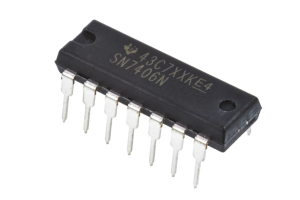
SN7406N IC: endri-javatra, fanamafisana ny PIN, ary safidy fanoloana
amin'ny 2024/09/29
Lahatsoratra malaza
-

Inona ny gnd ao amin'ny faritra?
amin'ny 1970/01/1 2937
-

Torolàlana momba ny konkera RJ-45: Kaody Connector RJ -5
amin'ny 1970/01/1 2499
-
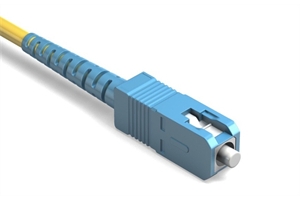
Karazan-kofehy fibre: SC SC Vs LC sy LC Vs Mtp
amin'ny 1970/01/1 2089
-
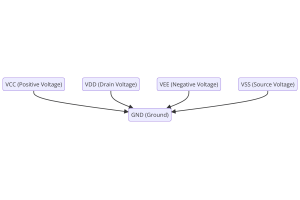
Fahatakarana ny famatsiana herinaratra amin'ny elektronika VCC, VDD, VEE, VSS, ary GND
amin'ny 0400/11/9 1890
-

Fampitahana eo amin'ny DB9 sy RS232
amin'ny 1970/01/1 1761
-

Inona ny bateria LR44?
Ny herinaratra, ny hery mahery vaika, ny lafiny mangingina amin'ny lafiny rehetra amin'ny fiainantsika andavanandro, avy amin'ny gadget tsy misy dikany amin'ny fitaovana ara-pitsaboana manohintohina, dia manana anjara toerana mangina izy io.Na izany aza, ny tena an-tsokosoko an'io hery io, indrindra ny fomba hitehirizana sy ny famoaham-barotra ara-pahombiazana dia tsy mora ny asa.Manohitra ity seh...amin'ny 1970/01/1 1712
-

Fahatakarana ny Fundamentals: Fanoherana ny tsy fitovian-kevitra, Andcapacitance
Ao amin'ny dihy an-tsokosoko amin'ny endri-tsoratra elektrika, ny singa iray amin'ny singa fototra dia mitaky ny dingana afovoany: ny tsy fahampiana, ny fanoherana ary ny fahaiza-manao.Ny toetra tsirairay dia toetra tsy manam-paharoa izay manondro ny gadona mavitrika amin'ny faribolana elektronika.Eto, dia nandeha tamin'ny dia izahay mba hamaritana ny fahasarotany amin'ireto singa ireto, hanilihan...amin'ny 1970/01/1 1652
-

Torolàlana ho an'ny CR2430: Fomba feno: Famaritana, fampiharana ary fampitahana amin'ny bateria cr2032
Inona ny bateria CR2430?Tombontsoa amin'ny bateria CR2430NormFampiharana bateria CR2430CR2430 mitovyCR2430 vs Cr2032Haben'ny bateria CR2430Inona no tadiavina rehefa mividy ny CR2430 sy ny fitovianaData Sheet PDFFanontaniana matetika Ny bateria dia ny fon'ny fitaovana elektronika kely.Anisan'ireo karazana maro misy, ny sela vola madinika dia manana anjara toerana lehibe, izay matetika hita ao amin'...amin'ny 1970/01/1 1551
-

Inona no rf ary nahoana isika no mampiasa azy io?
Ny teknolojia onjam-peo (rf) teknolojia dia ampahany lehibe amin'ny serasera tsy misy ara-barika maoderina, manome ny fifindran'ny angona mihoatra ny lavitra tsy misy fifandraisana ara-batana.Ity lahatsoratra ity dia namakivaky ny fototry ny RF, nanazava ny fomba nametrahan'ny taratra elektromagnetika (EMR) ny fifandraisana RF.Handinika ny fitsipiky ny Emr izahay, ny fananganana sy ny fifehezana n...amin'ny 1970/01/1 1538
-

CR2450 VS CR2032: Afaka ampiasaina ve ny bateria?
Ny bateria any Lithium manganese dia misy fitoviana misy bateria lithium hafa.Ny halehiben'ny angovo sy ny fiainana fanompoana lava dia ny toetra mampiavaka azy ireo.Ity karazana bateria ity dia nahazo ny fahatokisana sy ny fankasitrahana ny mpanjifa maro noho ny fiarovana tokana azy manokana.Gadget teknolojia lafo vidy?Fitaovana kely ao an-tokantranontsika?Jereo manodidina ary hahita azy ireo na ...amin'ny 1970/01/1 1511


